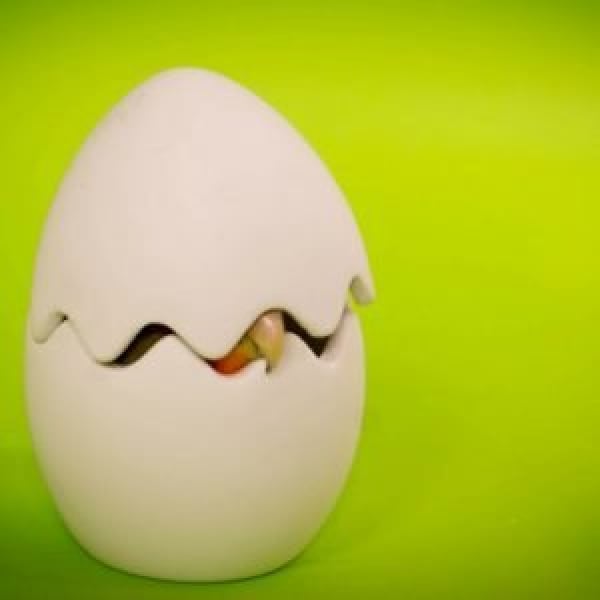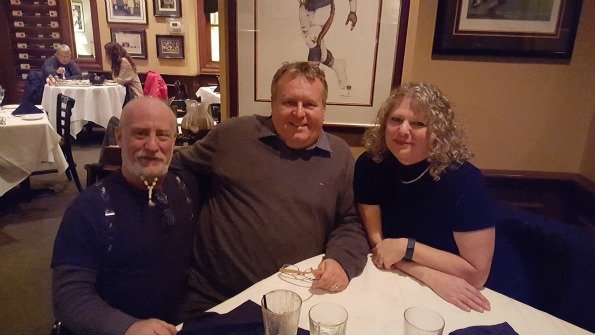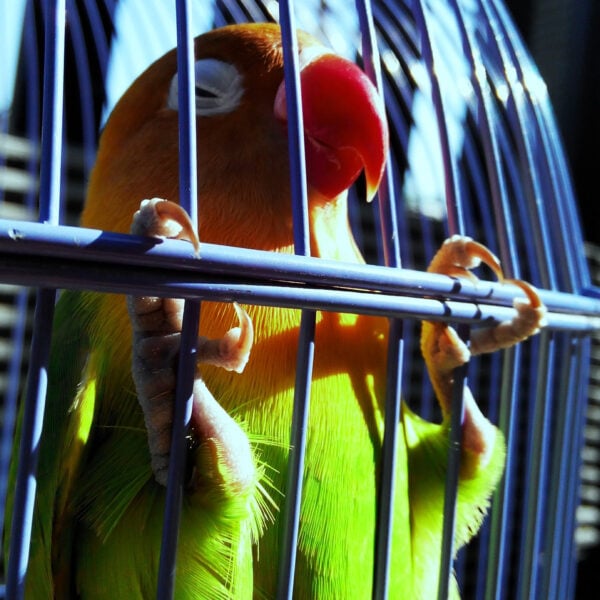Last Updated on by Mitch Rezman
Mark Hagen is to Parrot Knowledge as Dennis Yu is to social media or as Michael Jordan is to basketball.
His knowledge base of parrot breeding is second to none.
He’s got a Master’s Degree in agriculture and runs the largest single parrot research Institute on the planet – HARI.
He IS the creator of Hagen bird food.
Great meeting with Mark Hagen, excellent food @ Mike Ditka’s restaurant.
We love being your destination for exploring the behavior of the birds we keep in cages for decades.
But in order to triangulate caged bird-keeping best practices, we cannot be your only authority site destination.
If you have a bird(s) or thinking of getting a bird, visit HARI (Hagen Avicultural Research Institute) on your to-do list.
Their new site is visually stunning and the information offered within is second to none when it comes to caged bird keeping.
This is a facility that partners with veterinarians at the Ontario Veterinary College (OVC) as well as other institutions of higher learning in Canada.
Hagen understands how to view the care of parrots holistically.
Their contributions go beyond just creating better bird food. As an example:
A recent donation from Mark Hagen, on behalf of the Hagen Avicultural Research Institute (HARI) and Rolf C. Hagen Inc., has equipped the Ontario Veterinary College’s (OVC) Avian and Exotic Service with minimally invasive equipment to perform endo-surgical procedures on parrots.
The instruments are tiny – 2 mm forceps – and are essentially the same instruments used for neonatal surgery in human medicine.
In 2010 Mark gave the college $100,000 over 2 years
I have a lot of voices chatting in my head just about 24/7.
At the end of the day, I do ask them to come up with some sort of consensus and then be quiet so I can enjoy a sip of Jameson’s and some silence for a few minutes.
The building of our blog posts is not a structured activity. Some fact-checking here, research information there – I start laying it out and wireframing it on Monday night then work on it every day till as late as midnight Friday. What you get is what I’ve coined reduction content leading to create what we feel are the best practices for caged bird keeping in the 21st century.
I use the term “reduction content” as an analogy to reduction cooking. From Wikipedia – In cooking, a reduction is the process of thickening and intensifying the flavor of a liquid mixture such as a soup, sauce, wine, or juice by simmering or boiling.
The words we produce for you providing information about caged bird keeping are arrived at using 1 part science 1 part art and then we allowed it all to simmer during the week, tasting as we go.
Drifting>>>> growing up in the Jewish neighborhood of West Rogers Park in the 50s and 60s. Although living in a reformed household I couldn’t avoid eating Cholent which is a traditional Jewish stew. It is usually simmered overnight, for 12 hours or more, and eaten for lunch on Shabbat. Really good stuff!
No one ever made it in our family. I’ve always eaten it in a Jewish Deli. Some of the best comfort food ever.
<<<<moving off the highway rumble strips
I’m going to go out on the limb here and say that the Internet has become the biggest pile of digital trash in the universe when it comes to “reliable” information.
Mitchism 246 – information on many Facebook bird groups is exponentially worse than general information found on the Internet.
I’m here if you want to debate me.
Quick swerve >>>> if you’ve been reading me for a while you know I get “drifty.”
The former CEO of Google, Eric Schmidt made the observation that Every 2 Days We Create As Much Information As We Did from the beginning of time until 2003.
I was at a geek marketing event (SEMPO) sponsored by Website Magazine.
Besides talking about how to get all of you to find us and no one else in search, a couple of the attendees were current and/or former caged bird keepers.
Networking events are cool because you can walk up to total strangers introduce yourself and be in a conversation about something you have in common related to the event.
Because WindyCityParrot.com was placed on the big screen in front of the audience for analysis and criticism, I found some caged bird keepers in the group.
I randomly approached a table and one of the women at the table said that she had a mating pair of cockatiels for the past 17 years but wasn’t seeing any eggs.
This created two streams of conversation.
My conversation with the women who had the cockatiels elicited the fact that her birds had a light on all night after everyone else went to sleep.
She did not cognize the relationship between 24/7 lighting and the loss of egg production (we talk about that in-depth – below).
A gentleman at the same table, someone who’s never had birds was confused about how a female bird can produce eggs without the presence of a male.
I can see where this would befuddle (non-bird) people.
The main attraction is about to begin
Chronic egg laying as in “I want my freakin’ bird back”.
I’m tired of her snarling at me if I want to change her cage paper. I want her out of the cage annoying me with her head butting up against my fingers requesting perpetual scritching.
This is a serious health issue. Heard on the street and on social media:
“My cockatiel laid eggs for eight months, before she died” “My budgie laid lots of eggs for about a year and then she died”, “I loved my green cheek conure who laid eggs for about six months, and then passed away”.
With Popcorn being a chronic egg-layer we made the decision to try to terminate this chronic egg-laying cycle with some procedures that we’ve talked about amongst ourselves and with you but never thought about deploying for our own bird.
Until now we’ve tolerated the random eggs, and have tried to help her be near the eggs by transporting the egg every time we transported her which was five or six days a week – she goes with us everywhere.
But you know birds, they’re like ADD children they’re easily distracted, eggs break (before you say something read about what we’re now doing with fake eggs) so she’s never really been “on the eggs” until now – for 14 days.
We found 72 hours of light to break a bird’s circadian time clock and their hormonal need to consistently reproduce from Harrison’s – the most vocal advocate of this procedure.
More about controlling your bird
using the zombie death grip for birds
My issue was with Harrison’s recommendations that the light be 1000 lumens – and I’m sure by now you’re probably tired of my whole inverse square properties of light rant.
I called Harrison’s and spoke to customer service where I posed my question regarding the inverse square conundrum – this was their comprehensive email response.
Thank you for your phone call earlier today.
In regard to the light cycle therapy based off of Dr. Kevin Wright’s (an avian veterinarian) experience, it is not the actual amount of lumens the bird is exposed to but the continued exposure to light, in an enclosure without dark zones, offered consistently for 72 hours should be sufficient to break the hormonal cycle (that triggers egg-laying).
The amount of lumens is not the critical factor – but that the light within the enclosure or room is consistently bright enough to break the “night cycle”.
Why do you recommend 72 hours of continuous light for cases of chronic egg laying?
The 72 hours of light is used to reset the circadian rhythm.
I am concerned with how the continuous light will affect my bird. Will it be able to sleep? Won’t it stress my bird?
Your bird will be able to sleep in the light. Continuous light is much less stressful than chronic egg-laying or egg binding.
Can the lights be dimmed during the night or does the light need to be bright the entire 72 hours?
The same light without variation (brightness) must be used for the entire duration (3 days = 72 hours) for this to be effective.
If I am unable to remove the bird from the same room as my other pets, how will 72 hours of continuous light affect pets that do not have any issues?
The light will not harm the other animals in the room.
The time frame for results varies depending on the animal and the severity of each individual case.
In the process of trying to recover our cockatiel as a pet, we have been interacting with many of you seeking the same solutions that you are.
Our panning for gold nuggets of content about chronic egg laying from our content gold-mining hopper has yielded some of these answers.
I purchased dummy eggs about 3 months ago. Prior to getting the dummy eggs, I tried numerous things (re-arranged the cage, moved cage location, totally changed cage to different cage, gave longer night hours, limited food to just pellets, removed all toys from the cage).
Nothing worked.
Dummy eggs did the trick!!! It says in the brochure that your hen might lay 2 more eggs & stop.
My hen did just that! 🙂 I have found though if I remove the dummy eggs, she will start laying again.
I left them in for 30 days and took them out of the cage & she started laying again.
So now dummy eggs are a permanent fixture in my cockatiel’s cage.
I have made an appointment with an avian vet to see her also. Good luck with your little hen! 🙂
Interesting. I only had one, but I got it stopped by shortening the day, reducing fresh foods, and bathing opportunities since these are all keys to tell the bird to a breed — enough sun to forage for self and babies, enough available food, plenty of water.
It only took about two and a half weeks of this situation to get her to stop.
Fortunately, she stopped and was eventually given a mate and allowed to raise one clutch of babies, never again laying without proper triggers like the nest box, summer’s long days, and lots of extra fresh foods and a big bath bowl.
Since I was concerned she might go back to egg-laying, I put the mated pair in the “retired” aviary and they enjoyed a good long life together.
This method, however, makes sense. I know that when we change time [daylight savings], it helps me if I stay up longer by several hours for a few days after.
It does allow my body to adjust a bit to the new daylight length.
Sounds like a good topic for some time in the future, like springtime when this behavior is most likely to appear, at least in budgies and ‘tiels, at least from my experience and discussions with other parrot parents.
That said, I miss Popcorn. The Popcorn would fly to my shoulder the moment I got home and opened her cage door.
The Popcorn that loved flying to the kitchen while we were making salads and fly back into our living room to munch on our salads while we watched TV.
I’m not ashamed to admit I’m desperate for her company.
Here’s what we are doing to recover our bird from that nefarious cult of chronic egg-laying cockatiels.
Because of my responsibilities during the day at the Birdie boutique, it is difficult to produce much fresh content.
For those of you who don’t know I write most of my content between 10 PM and 4 AM Central Standard Time during the week.
That means I usually do not arise until 9 o’clock or 10 o’clock AM.
Typically upon awaking, I would open up Popcorn’s cage door and turn on her overhead full-spectrum light.
While she is on the eggs I am now turning the light on when I leave home which is 11 or 12 o’clock.
We usually get home from the shop around five or six and I now immediately turn her light off.
Every morning I would prepare a fresh square of Lafeber’s Avicakes with the light dusting of Lafebers Avi-Era multivitamin supplement from a salt shaker.
She no longer gets that.
We are also removing her Tweeky Clean Feeder when we go to bed at night and reintroducing it into the birdcage in the morning.
She also has a very large cuttlebone of which she has been taking advantage.
She started sitting on the eggs on October 8 so 21 days would make it October 29. We may even go to 30 days before we expose her to 72 hours of full-spectrum lighting.
We have ordered and received six fake cockatiel eggs.
After some debate, we decided to not introduce the eggs at this time because if we are fortunate enough to stop the egg-laying cycle we won’t know if it’s the eggs or the light cycle therapy that did it.
The best news we have is since she’s been sitting on two eggs, the count has remained at two.
Prior to this, we were seeing two and three eggs every week. So far so good.
Get ready Popcorn – it’ll be a bright 3 days and nights.
For those of you who think that withholding the Avicakes and removing the tidy seed feeder at night is a bit draconian.
We feel that these procedures will not harm her in any way.
We’re doing this because if the bird feels as though food is plentiful, she may be more inclined to reproduce because she is able to care for her “expected” babies.
By making less food available, she may intuitively question food availability and reduce the production of future eggs because she’s thinking that not enough food will be available to help future offsprings survive.
The real downside is with all we’ve done for our little white fluffy ball of feathers Popcorn is treating us like strangers.
Our morning routine mentioned above – is gone..
She would happily follow me around the apartment.
If I was at the bathroom sink she would be on the shower bar – chirp chirp chirp chirp chirp and I would answer her as though she was another human being.
Going to the kitchen she likes being on her stand on the table or on top of the refrigerator or the crown molding.
She would follow me with her eyes knowing that the kitchen was where the food was made.
I started working on coaxing her to fly to me with half of a thimble full of millet which she would do anything for.
She would help me make the bed by standing on top of the comforter and I would gently float it out and bounce her up and down and she would just nonchalantly move to another part of the bed with three or four-wing flaps but I think she was having fun on the ocean of fabric.
This morning was the first morning where she had been without food all night and no supplemental anything.
I opened the cage door went to the bathroom for something and was about to get her tidy seed from the kitchen but there she is on the Booda perch on the top of her cage chirp chirp chirp chirp – clearly being “where’s my food – where’s my food” chirp.
I reinstalled the Tweeky Clean feeder containing Higgins Sunburst Cockatiel this morning and took a step back.
Totally ignoring me she climbed down from the Booda perch on top of her cage, stuck her head into her feeder – pigged out for two minutes then went back to the eggs. I was hurt – did I mention I want my freakin’ bird back.
All of you will be kept in the loop of this attempt to break our cockatiel’s chronic egg-laying cycle. Please keep your comments flowing.
So I’m ready for another cup of coffee and a bagel with a shmear – how about you?
Written by Mitch Rezman
Approved by Catherine Tobsing
Author Profile
Latest entries
 The Traveling BirdJune 26, 2025Can You Name 5 Parrot Species That Are Living Wild in the USA?
The Traveling BirdJune 26, 2025Can You Name 5 Parrot Species That Are Living Wild in the USA? Bird BehaviorJune 26, 2025How is it Parrots Are Problem Solvers Social Animals and Even Use Tools?
Bird BehaviorJune 26, 2025How is it Parrots Are Problem Solvers Social Animals and Even Use Tools? Bird & Parrot AnatomyJune 25, 2025How a Tiny Chemical Modification Makes Parrots Nature’s Living Paintings
Bird & Parrot AnatomyJune 25, 2025How a Tiny Chemical Modification Makes Parrots Nature’s Living Paintings PigeonsJune 20, 2025How Do Parrots Thrive in Cities Outside Their Native Habitats?
PigeonsJune 20, 2025How Do Parrots Thrive in Cities Outside Their Native Habitats?





